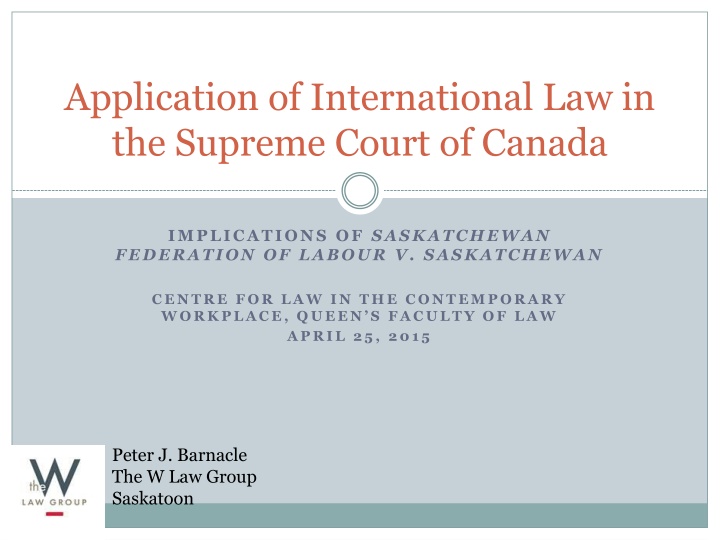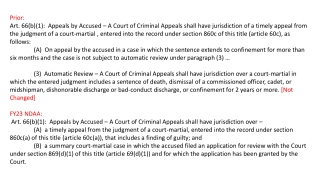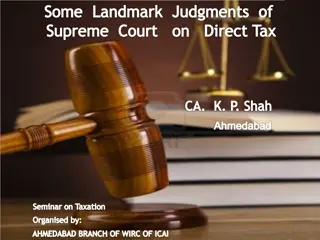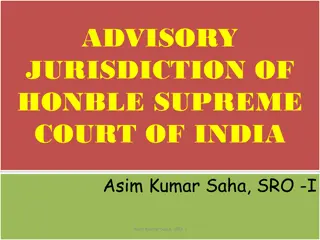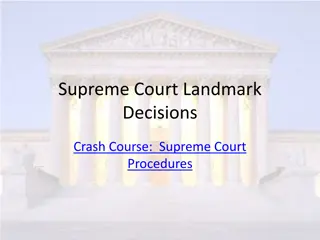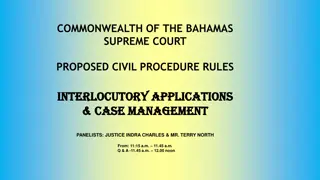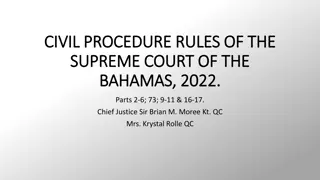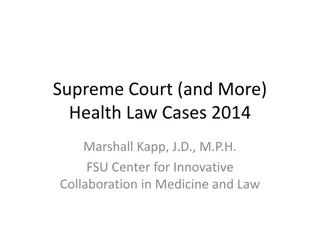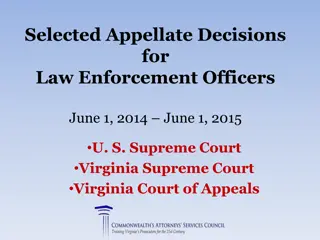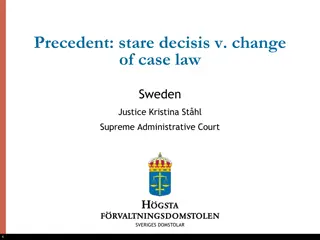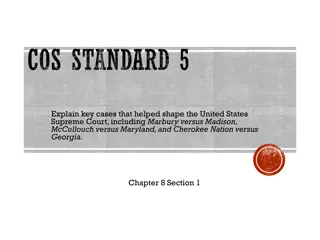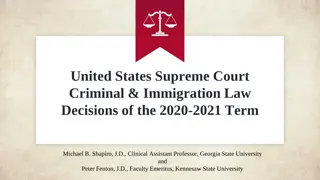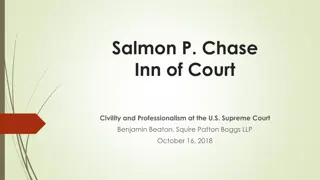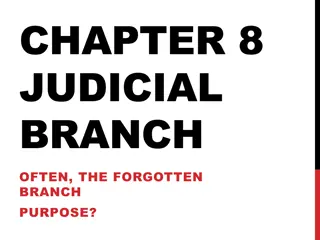Implications of International Law in the Supreme Court of Canada
This article discusses the application of international law in the interpretation of freedom of association in the context of the Charter of Rights and Freedoms in Canada. It explores the constitutional objections, the role of international law, relevant substance, and the common understanding of freedom of association influenced by international law.
Download Presentation

Please find below an Image/Link to download the presentation.
The content on the website is provided AS IS for your information and personal use only. It may not be sold, licensed, or shared on other websites without obtaining consent from the author.If you encounter any issues during the download, it is possible that the publisher has removed the file from their server.
You are allowed to download the files provided on this website for personal or commercial use, subject to the condition that they are used lawfully. All files are the property of their respective owners.
The content on the website is provided AS IS for your information and personal use only. It may not be sold, licensed, or shared on other websites without obtaining consent from the author.
E N D
Presentation Transcript
Application of International Law in the Supreme Court of Canada IMPLICATIONS OF SASKATCHEWAN FEDERATION OF LABOUR V. SASKATCHEWAN CENTRE FOR LAW IN THE CONTEMPORARY WORKPLACE, QUEEN S FACULTY OF LAW APRIL 25, 2015 Peter J. Barnacle The W Law Group Saskatoon
Considerations 1. constitutional objections to utilizing international law in the interpretation of freedom of association; 2. the role of international law in interpretation of freedom of association under the Charter; 3. substance of international law relevant to the interpretation of freedom of association under the Charter; and 4. recognition of the development throughout the world of a common understanding of the meaning of freedom of association in domestic law influenced or based on international law.
Constitutional Objections Offends Principles of Federalism Offends Principles of Federalism Charter itself reflects the application of the governing principles of federalism in our system. Ratified by the requisite number of provinces, including Saskatchewan, after an extensive period of dialogue between the federal and provincial governments. Canada Act, 1982, to which the Constitution Act, 1982, and hence the Charter, is a Schedule, passed by the Parliament of the United Kingdom pursuant to a joint resolution request of both the Canadian House of Commons and Senate. Terms of that joint resolution had been agreed to at a First Ministers Conference in November of 1981 by the First Ministers of nine of ten provinces (excluding Qu bec).
Constitutional Objections Contd. Health Services Health Services (2007) at para. 69 (2007) at para. 69 Under Canada s federal system of government, the incorporation of international agreements into domestic law is properly the role of the federal Parliament or the provincial legislatures. However, Canada s international obligations can assist courts charged with interpreting the Charter s guarantees (see Suresh v. Canada (Minister of Citizenship and Immigration), 2002 SCC 1 (CanLII), [2002] 1 S.C.R. 3, 2002 SCC 1, at para. 46). Applying this interpretive tool here supports recognizing a process of collective bargaining as part of the Charter s guarantee of freedom of association.
Constitutional Objections Offends the principle of dualism Offends the principle of dualism Charter Charter is the implementation of international human rights obligations to which Canada is bound. Charter Charter reflects linkage with international human rights obligations
International Labour Law: the Why Dickson, C.J. Dickson, C.J. Alberta Reference Alberta Reference (1987) at para. 57 (1987) at para. 57- -60 60 (a) there is a body of treaties, conventions and customary norms that comprise international human rights law and reflect the commitment of the nations of the world to ensure freedom, dignity and social justice for their citizens; (b) the Charter conforms to the spirit of the international human rights movement and incorporates many of polices and prescriptions of the various international documents pertaining to human rights ; (c) various sources of international human rights law declarations, covenants, conventions, judicial and quasi-judicial decisions of international tribunals, customary norms must be relevant and persuasive sources for interpretation of the Charter's provisions ;
The Why (d) given the similarity in policies and provisions of the Charter and international human rights Conventions, considerable relevance is attached to decisions of adjudicative bodies in supplying content to imprecise Charter rights such as freedom of association; (e) Canada is party to a number of international human rights treaties that contain similar or identical provisions to those in the Charter; (f) Canada has obliged itself internationally to ensure within its borders the protection of certain fundamental rights and freedoms which are also contained in the Charter .
The Why Principles from Statutory Interpretation R. v. Hape R. v. Hape (2007) per LeBel J., para. 53 (2007) per LeBel J., para. 53 [Presumption of conformity in statutory interpretation] [Presumption of conformity in statutory interpretation] It is a well-established principle of statutory interpretation that legislation will be presumed to conform to international law. presumed to conform to international law. The presumption of conformity The presumption of conformity is based on the rule of judicial policy that, as a matter of law, courts will strive to avoid constructions of domestic law pursuant to which the state would be in violation of its international obligations, unless the wording of the statute clearly compels that result. [emphasis added]
Principles of Statutory Interpretation R. v. Hape R. v. Hape, para. 53 , para. 53 [Avoid Construction Causing Breach] [Presumption apply with [Avoid Construction Causing Breach] [Presumption apply with values and principles] values and principles] First, the legislature is presumed to act in compliance with Canada's obligations as a signatory of international treaties and as a member of the international community. In deciding between possible interpretations, courts will avoid a construction that would place Canada in breach construction that would place Canada in breach of those obligations. The second aspect is that the legislature is presumed to comply with the values and principles presumed to comply with the values and principles of customary and conventional international law. [emphasis added] act in compliance with avoid a
Principles of Statutory Interpretation R. v. Hape R. v. Hape, para. 54 [Presumption of conformity] [Presumption of conformity] , para. 54 The presumption of conformity presumption of conformity has been accepted and applied by this Court on numerous occasions... The presumption applies equally to customary international law and treaty obligations. [emphasis added]
International Labour Law and Charter Interpretation: the How Dickson, C.J. Dickson, C.J. Alberta Reference Alberta Reference (1987) (1987) Para. 59 [Presumption to provide protection at least as great] Para. 59 [Presumption to provide protection at least as great] ... I believe that the Charter should generally be presumed to provide protection protection at least as great as that afforded by similar provisions in international human rights documents which Canada has ratified. [emphasis added] be presumed to provide Para. 60 [Relevant and Persuasive Source for Interpretation] Para. 60 [Relevant and Persuasive Source for Interpretation] In short, though I do not believe the judiciary is bound by the norms of international law in interpreting the Charter, these norms provide a relevant and persuasive source and persuasive source for interpretation of the provisions of the Charter, especially when they arise out of Canada's international obligations under human rights conventions. [emphasis added] relevant
The How Dickson, C.J Dickson, C.J. Alberta Reference, at para. 79 . Alberta Reference, at para. 79 [Recognizing same level of Protection] [Recognizing same level of Protection] In summary, international conventions to which Canada is a party recognize the right of the members of unions to engage in collective bargaining, as part of the protection for freedom of association. It is reasonable to infer that s. 2(d) of the Charter should be interpreted as recognizing at least the same level of should be interpreted as recognizing at least the same level of protection protection. [emphasis added]
The How - Section 1 Slaight Communications (1989), Dickson, C. J. at para. 23: [Inform interpretation of Charter rights] [Inform interpretation of Charter rights] Given the dual function of s. 1 identified in Oakes, Canada's international human rights obligations should inform not only the interpretation of the should inform not only the interpretation of the content of the rights guaranteed by the content of the rights guaranteed by the Charter what can constitute pressing and substantial s. 1 objectives which may justify what can constitute pressing and substantial s. 1 objectives which may justify restrictions upon those rights restrictions upon those rights. Furthermore, for purposes of this stage of the proportionality inquiry, the fact that a value has the status of an international human right, either in customary international law or under a treaty to which Canada is a State Party, should generally be indicative of a high degree of importance attached to that objective importance attached to that objective. This is consistent with the importance that this Court has placed on the protection of employees as a vulnerable group in society. [emphasis added] Charter but also the interpretation of but also the interpretation of a high degree of
The How R. v. Hape R. v. Hape, para. 55 , para. 55 [Ensure consistency] [Ensure consistency] This Court has also looked to international law to assist it in interpreting the Charter. Whenever possible, it has sought to ensure consistency ensure consistency between its interpretation of the Charter, on the one hand, and Canada's international obligations and the relevant principles of international law, on the other... [emphasis added]
The How Health Services Health Services (2007), at para. 78 (2007), at para. 78 [Persuasive Source for interpreting scope] [Persuasive Source for interpreting scope] ... Canada's current international law commitments and the current international law commitments and the current state of international thought current state of international thought on human rights provide a persuasive source for interpreting the scope of the Charter. [emphasis added]
The How SFL SFL (2015) (2015) [Ensure Consistency] [Presumption at least as great a level] [Ensure Consistency] [Presumption at least as great a level] [64] LeBel J. confirmed in R. v. Hape, 2007 SCC 26 (CanLii), [2007] 2 S.C.R. 292, that in interpreting the Charter, the Court has sought to ensure consistency between its interpretation of the Charter, on the one hand, and Canada s international obligations and the relevant principles of international law, on the other : para. 55. And this Court reaffirmed in Divito v. Canada (Public Safety and Emergency Preparedness), 2013 SCC 47 (CanLii), [2013] 3 S.C.R. 157, at para. 23, the Charter should be presumed to provide at least as great a level of should be presumed to provide at least as great a level of protection protection as is found in the international human rights documents that Canada has ratified . [emphasis added]
The How SFL SFL, cont d, at para. 65 , cont d, at para. 65 [Presumption at least as great a level] [Presumption at least as great a level] Given this presumption, Canada s international obligations clearly argue for the recognition of a right to strike within s. 2(d).
How the Role in Charter Interpretation is Framed Presumed provide at least as great level of protection Relevant and persuasive source Recognizing same level of protection Inform interpretation of Charter rights Ensure consistency with international obligations Persuasive source for determining scope Presumption of conformity Presumed to comply
Role in Charter Interpretation Do all these mean the same thing? If not, is SFL the last word?
Substance of International Law: The What Statute of the International Court of Justice Statute of the International Court of Justice (1945) (1945) (a) (a) International conventions International conventions, whether general or particular, establishing rules expressly recognized by the contesting states; (b) International custom International custom, as evidence of a general practice accepted as law; (c) The general principles of law general principles of law recognized by civilised nations; (d) Judicial decisions and teachings of the most highly qualified Judicial decisions and teachings of the most highly qualified publicists of the various nations publicists of the various nations, as subsidiary means for the determination of rules of law. (b) (d)
Treaties and Conventions: The What Vienna Convention on the Law of Treaties (1969) Article 26 Pacta sunt servanda Article 26 Pacta sunt servanda Every treaty in force is binding upon the parties to it and must be performed by them in good faith.
Treaties: The What The UN Framework Regional Treaties ILO Constitution and Ratified Conventions Interpretations by specialized agencies - custom and practice? [Unratified treaties]
Customary International Law Two elements to establish international customary law: General Practice interpreted to mean state practice based on how states behave. opinio juris based on state behaviour, the practice is accepted as law
Application SFL, para. 69 The relevant and persuasive nature of the Committee on Freedom of Association jurisprudence has developed over time through custom and practice and, within the ILO, it has been the leading interpreter of the contours of the right to strike.
The Dispute at the ILO Tripartite Meeting on the Freedom of Association and Protection of the Right to Organise Convention, 1948 (No. 87), in relation to the right to strike and the modalities and practices of strike action at national level Geneva 23 25 February 2015
Outcome Appendix I Appendix I The ILO Standards Initiative The ILO Standards Initiative Joint Statement of Workers & Employers Groups (23.02.2015) [EXCERPTS] Employers Groups (23.02.2015) [EXCERPTS] The right to take industrial action by workers and employers in support of their legitimate industrial interests is recognised by the constituents of the International Labour Organisation. Joint Statement of Workers &
Outcome Appendix II Appendix II Government Group Statement (23/2/2015) [EXCERPTS] Government Group Statement (23/2/2015) [EXCERPTS] 4. The Government Group recognizes that the right to strike is linked to freedom of association which is a fundamental principle and right at work of the ILO. The Government Group specifically recognizes that without protecting a right to strike, Freedom of Association, in particular the right to organize activities for the purpose of promoting and protecting workers interests, cannot be fully realized.
Develop of a Common Understanding: What is Everyone Else Doing Health Services Health Services, at para. 78 ... Canada's current international law commitments and the current state of international thought the current state of international thought on human rights provide a persuasive source for interpreting the scope of the Charter. [emphasis added] , at para. 78
SFL SFL, para. 71 , para. 71 Additionally, there is an emerging international consensus emerging international consensus that, if it is to be meaningful, collective bargaining requires a right to strike. [emphasis added]
Conclusion However, one wishes to frame its application, the use of international labour law in Charter litigation is now a feature of our constitutional law. We will all have to pay more attention.
